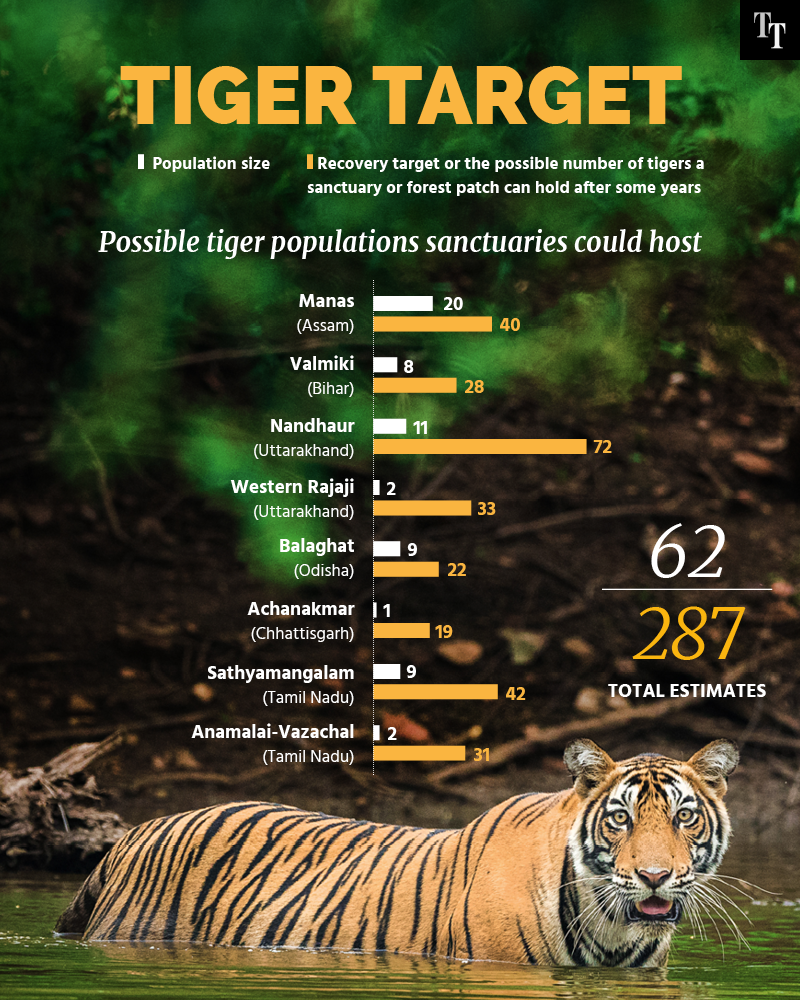What is the issue?
The killing of tigress Avni shows that a large number of tiger population are living outside its reserves, making the species vulnerable.
Click here to know more on the issue.
Why is the death of tigress Avni controversial?
- Since 2016, the deaths of 13 people in the Pandharkawda divisional forest of Maharashtra have been attributed to tigers and at least five of them to Avni, which is 6-year-old with two cubs.
- India’s wildlife laws permit a tiger which is believed to have preyed on humans to be killed.
- The State’s chief wildlife warden claimed he had evidence that the tigress involved in those killings.
- Hence, a decision was taken to shoot T1 (known as Avni) in January but stayed by the Bombay High Court after appeals by activists.
- Three more deaths later, the Supreme Court cleared the way for the forest department to have the tiger killed in September.
- On November 2, it emerged that forest officials along with a hunter, claimed to have chanced upon the tiger which, they said, charged at them.
- The hunting party failed to tranquilise Avni, as the rules required, and shot at it fatally.
- Several activists and some veterinarians have alleged that no attempt was made to tranquilise the animal and they described the killing as “murder”.
- Thus, the National Tiger Conservation Authority has commissioned an independent team of wildlife experts to investigate the killing.
How serious is the tiger-human conflict in India?
- The killing of a man-eating tigress is a rare but not unprecedented in India.
- Tigers are India’s apex predators and symbols of its success at conservation.
- Hence, the unusual death of even one tiger causes disquiet in forest departments and among conservation biologists, tourism officials and activists.
- According to information from the Rajya Sabha, out of 553 tiger deaths from 2012 to 2017, 22.1% were due to poaching, 15.4% were seizures, and 62.4% were attributed to natural causes and causes not attributable to poaching.
- India has 50 tiger reserves, but with forest area increasingly spilling into hamlets, there have been several instances of tigers preying on cattle, livestock and people.
- Days after the killing of Avni, villagers in Lakhimpur Kheri, U.P., crushed a tiger to death with a tractor after it fatally attacked a farmer.
- Hence despite conservation measures, killing of tigers continue to be present in India.
What does the WWF study suggest?
- World Wide Fund for Nature has recently conducted a study on the tiger reserves, that hold the potential to host tiger populations around the world.
- The exercise comes against the backdrop of goal tiger range countries which had set for themselves in 2010 to double the world’s tiger population from 3,200, as estimated then, to over 6,000 by 2022.

- It has found that eight forest patches in India can collectively support more than four times their current tiger populations, although the timelines for these increases could range from years to decades.
- The tiger population in the eight sanctuaries distributed across eastern, central, northern and southern India could increase from the current estimated count of 62 to 287.
- The eight Indian sanctuaries are part of 18 tiger “recovery sites” in Asia that the WWF researchers assessed to determine how many tigers each site might support with available prey and conservation efforts.
- Also a study, published in the journal PLOS One, has estimated that the 18 sites, which at present support 165 tigers, have the potential to harbour 585 tigers.
- However, future tiger populations at these sites would hinge on conservation efforts to maintain enough prey and minimise the risk of human-tiger conflicts.
- Also there is a larger concern that a few tiger reserves are being pampered at the expense of others.
What should be done?
- India’s estimated tiger count increased from 1,706 in 2010 to 2,226 in 2014, a population rise widely cited as a measure of success of Project Tiger launched in 1972.
- However, conservation scientists caution that habitat loss has meant that there is increasingly less space for tigers.
- Thus, interventions to improve the tiger population will need to be site-specific.
- In addition to the need of tiger supplementation through reintroductions, the success of recovery will depend on first improving protection and management practices.
- Wildlife specialists believe India will need to significantly expand well-protected tiger habitats in the coming decades.
- Conservationists have also said that “man-eaters” is a legacy term from colonial hunters and incorrect in today’s times.
- Tigers don’t actively seek out humans and it is only because of increased contact between humans and animals that there are more conflicts which leads to deaths.
- Thus, India needs to focus on massive funding of voluntary relocation of human settlements in new landscapes to make room for expanding conflict-free tiger habitats.
Source: The Hindu
